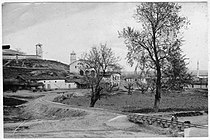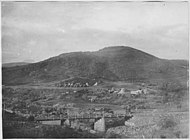Kodza-Déré-Decauville
| Kodza-Déré-Decauville | |||||||||||||||||||||||||||||||||||||||||||||||||
|---|---|---|---|---|---|---|---|---|---|---|---|---|---|---|---|---|---|---|---|---|---|---|---|---|---|---|---|---|---|---|---|---|---|---|---|---|---|---|---|---|---|---|---|---|---|---|---|---|---|
|
Bridge crossing in May 1917
| |||||||||||||||||||||||||||||||||||||||||||||||||
|
Vróncho loop
| |||||||||||||||||||||||||||||||||||||||||||||||||
|
Former route on a modern map
| |||||||||||||||||||||||||||||||||||||||||||||||||
|
Historical map, September 1917
| |||||||||||||||||||||||||||||||||||||||||||||||||
| Route length: | 13.5 km | ||||||||||||||||||||||||||||||||||||||||||||||||
| Gauge : | 600 mm ( narrow gauge ) | ||||||||||||||||||||||||||||||||||||||||||||||||
|
|||||||||||||||||||||||||||||||||||||||||||||||||
The Kodza-Déré-Decauville ( Greek Κοτζά Ντερέ ντεκοβίλ ) was one in 1917 by the French army about 13.5 km long built military - narrow-gauge railway in Peonia at Polykastro in the Greek part of Macedonia .
Route
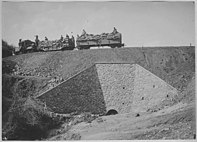
|
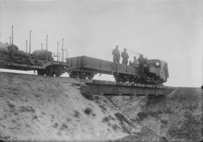
|
|
|
Train with sandbags on a high embankment
|
Bridge of the Vróncho loop
|
The Decauville -Bahn with a gauge of 600 mm began at the Axioupoli station ( Σταθμό της Αξιούπολης ), which was then still called Goumentja. She crossed the village of Axioupolis, which was called Bohemitsa (Μποέμιτσα) until 1927 and had two churches and a mosque. To gain altitude quickly, she went through an elaborate trassierte terminal loop by Pigí ( Πηγή ) that Isvor was called. From there it went along the Kodza-Déré river to the terminus "Black Tree" ( μαύρο δένδρο ) below the Koúpa mountain ( Κούπα ), from where the Allies supplied the troops on the Macedonian front with supplies , building materials and ammunition.
Locomotives
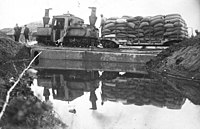
|
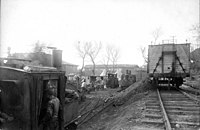
|
|
|
Péchot Bourdon double boiler locomotive
|
Three locomotives at Axioupoli (Goumentja) station
|
Double-boiler steam locomotives of the Péchot-Bourdon type specially developed for the transport of ammunition on French military railways were used on the route. They were constructed almost symmetrically, with the exception of the only one existing water lifter with suction hose and with small differences in the coal supply, heater seat, lubrication pump, fire hole and control levers. Unlike the British Double Fairlie locomotives, they only had one common steam dome in the middle of the locomotive. As a result, the water level in the area of the cathedral remained constant, regardless of the gradient of the route. The steam to the cylinders was directed through the pivot pins of the bogies. The cylinder units could be controlled independently of one another, so that a damaged locomotive could be driven out of the danger zone if necessary.
history
The valley of the Kodza-Déré River was during the First World War of strategic importance to the allied forces of the Entente . In the Axioupolis area was the French headquarters and in the Pigi area a training camp and a hospital for the treatment and care of the wounded. The front line ran a few kilometers above on the ridges along the Skra-di- Orte gorge ( Σκρα Ντι Λέγκεν ). Heavy battles with high casualties took place there.
First Battle of Skra-di-Legen (May 1917)
In May 1917, on the orders of General Sarrail, the Franco-Greek troops attacked the enemy positions at Skra-di-Legen for the first time. The 122nd Infantry Division, commanded by General Gérôme , was only able to capture part of the enemy positions before the Allies were repulsed by a Bulgarian counter-offensive. The situation stabilized after several months of fighting, during which both sides carried out further development work.
The Bulgarian armed forces had built their concrete entrenchments behind trenches secured by barbed wire fences. They were armed with carefully camouflaged machine gun nests and were supported by solid artillery. Numerous observation posts on the ridge completed the defense system.
Royal visit (February 1918)
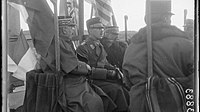
|

|
|
|
King Alexander on the Decauville Railway
|
General Guillaumat
|
On February 7, 1918, the Greek King Alexander, together with the French generals Adolphe Guillaumat and Gérôme, as well as the commander of the Greek 1st Division on the Decauville Railway, inspected the village of Pigí.
On the return trip via Edessa , the seat of the French support troops under Lieutenant Colonel Vicq, the young king was interested in the road works of the French army. The king was so absorbed in the work of the soldiers that the lieutenant colonel politely asked him why he was so interested in the work of his men. The young king then gave him the legendary answer: "I am learning the king's profession!" (" Μαθαίνω την δουλειά του βασιλιά! ")
Second Battle of Skra-di-Legen (May 1918)
In the spring of 1918 a new offensive began with the Greek army: The National Defense Corps ( Σώμα Στρατού Εθνικής Αμύνης ) under Lieutenant General Emmanouil Zymvrakakis consisted of the following three major organizations: Division Archipelago under General Dimitrios Ioannou , Division Crete under General Panagiotis Spiliadis and Serres division under Lieutenant Colonel P. Gardicas.
On May 27, 1918 General Adolphe Guillaumat visited the headquarters of the Greek 1st Division in Pigí, where he and General Gérôme set the date for the artillery and infantry attack on May 30, 1918. On the morning of May 29, 1918, the 430 artillery pieces of the Allied artillery began to continuously bombard the Bulgarian fortifications in order to destroy them as much as possible before the infantry attack. The artillery fire was well aimed, so that most of the Bulgarian machine gun nests were destroyed and breakthroughs were made in the barbed wire fences. The artillery continued the bombardment, harassment and destruction into the night.
On May 30, 1918, the three Greek divisions had the mission to drive the Bulgarians from the front line and take their fortifications. Due to a tactical error, a Greek sergeant gave the signal for the general attack half an hour early. The artillery then opened fire without waiting for the infantry to be ready for action. This prevented the expected surprise effect and gave the Bulgarians time to prepare. Lieutenant Colonel Georgios Kondylis had the cartridges removed from his soldiers' rifles and left them only the grenades and bayonets to drive the Bulgarians out of their trenches, which, due to the success, was also used in subsequent attacks.
The 3rd Battalion under Nikólaos Plastiras in the Archipelago Division was able to cross the seven consecutive lines of the Bulgarian defense, and penetrate 1.5 km into enemy territory and encircle it on the flanks. 150 soldiers of the 49th Bulgarian regiment and their 33 officers as well as their German advisors were captured. The Hellenic troops supported by the French occupied the front for a length of 12 km and occupied all the viewpoints on the surrounding mountain peaks. The Greek casualties totaled 441 casualties, 338 of them in the Archipelago division , 71 in the Crete division and 32 in the Serres division against more than 600 casualties on the Bulgarian side.
Historical meaning
The Allied victory at Skra-di-Orte was the result of well-planned, prepared and executed Franco-Hellenic military cooperation. The French artillery rained a flood of fire on the heavily fortified enemy positions and the Greek infantry crushed the bitter resistance of the defenders and stormed the Bulgarian positions.
General Guillaumat's work in the east was crowned by the battle of Skra-di-Legen. He was then on June 17, 1918 as the successor to General Auguste Dubail Military Governor in Paris.
post war period
The French bequeathed the Decauville narrow-gauge railways laid in this area to the Greek government, which in 1923 left their operation to the private entrepreneur and banker Epaminondas Charilaos , who owned and built the Charilaou settlement in Thessaloniki .
The narrow-gauge railways around Almopia were operated under the name Local Railways of Macedonia ( Τοπικοί Σιδηρόδρομοι Μακεδονίας ) until 1931 , but ceased operations in the economic crisis of 1936. Immediately afterwards, the demolition of the tracks began, and the locomotives and wagons were moved to other narrow-gauge networks.
The tracks and bridges in the Kodza-Déré Valley were dismantled in the post-war period, but the high embankments and deep cuts of the route are still visible in places today. The only surviving locomotive on the Almopia network is now on display in the Athens Railway Museum. The historical significance of the narrow-gauge railways for the region has largely been forgotten.
See also
Individual evidence
- ↑ "Επιχειρησιακό Πρόγραμμα Δήμου Παιονίας 2011-2014" (development program 2011-2014 of the municipality of Peonia) , official Greek spelling (Κοτζά Ντερέ ντεκοβίλ) on pages 25/32/45 and 289. Retrieved on December 8, 2019
- ↑ a b Κώστας Μανασής (Kostis Manasis): Αξιούπολη - Μποέμιτσα (Axioupoli - Bohemitsa). Retrieved August 20, 2018.
- ↑ Kodza-Dere (Macédoine). Pont construit par le Génie pour le Decauville. May 1917, Tétart . (PDF) p. 28. In: Les Petits Trains de la grande guerre . (HTML) Archives ECPAD Retrieved August 20, 2018.
- ↑ The PECHOT-Bourdon locomotive (1/12).
- ^ 'Historique de la compagnie 2/64 du 2e Régiment du Génie.' (PDF) Accessed August 21, 2018.
- ↑ Historique du 84 e RI Berger-Levrault ( ed. ). Digitized by Robert Jacob. Retrieved August 21, 2018.
- ↑ a b c d e f g Angel Angelidis: Première Guerre Mondiale: Le Front d'Orient, “La bataille de Skra-di-Legen”, 29-31 May 1918. Brussels, November 2015. Accessed 21 August 2018.
- ↑ a b c d Nikeforos Sivena : The Almopia Decauville train February 19, 2017. Accessed March 4, 2019.
- ↑ a b c d Νικηφόρου Σιβένα (Nikeforos Sivena): Η ιστορία της δημιουργίας του τρένου της Αλμωπίας (Καρατζόβας) (The history of the creation of the rail from Almopia (Karatzova)). February 1, 2017. Retrieved August 21, 2018.
- ↑ Région d'Isvor: visite du roi de Grèce au front grec; dans le Decauville, le roi et les généraux Guillaumat et Jérôme, 13 février 1918. Retrieved 21 August 2018.
Coordinates: 41 ° 0 ′ 10.4 ″ N , 22 ° 31 ′ 0.8 ″ E






